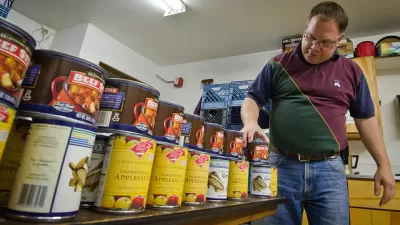From 2000-2011 the number of poor Americans living in the suburbs increased at a rate double that of the country's cities. The result is that more poor people now live in the suburbs than in cities. A new book examines this troubling trend.
Although elected officials and service providers "have yet to catch up to this new picture," the suburbanization of poverty "has been no quirk of the recession," says Emily Badger. "It began before the housing market crashed, and will inevitably tax communities unaccustomed to housing the poor well into and beyond the recovery."
A new book by Elizabeth Kneebone and Alan Berube, Confronting Suburban Poverty in America, "[paints] a new picture of poverty in America as well as the best ways to combat it."
So, why is the suburbanization of poverty so troubling? Because anti-poverty efforts "designed for dense urban neighborhoods transplant poorly onto suburbia," notes Badger. "We’ve seen that the suburban safety net – it’s much thinner, it’s much patchier, and it’s spread over greater distances," Kneebone says.
In addition, the auto-dependent land use patterns found in America's suburban communities exacerbate poverty. "Many suburbs, for instance, don't have the kinds of public transit networks that can connect impoverished neighborhoods to job opportunities," says Badger.
"All of this means that if the geography of poverty has dramatically changed over the last decade, we'll have to spend the next decade (and likely more) thinking about how to address it in its newest forms," she adds.
FULL STORY: The Suburbanization of Poverty

Alabama: Trump Terminates Settlements for Black Communities Harmed By Raw Sewage
Trump deemed the landmark civil rights agreement “illegal DEI and environmental justice policy.”

Study: Maui’s Plan to Convert Vacation Rentals to Long-Term Housing Could Cause Nearly $1 Billion Economic Loss
The plan would reduce visitor accommodation by 25% resulting in 1,900 jobs lost.

Planetizen Federal Action Tracker
A weekly monitor of how Trump’s orders and actions are impacting planners and planning in America.

Wind Energy on the Rise Despite Federal Policy Reversal
The Trump administration is revoking federal support for renewable energy, but demand for new projects continues unabated.

Passengers Flock to Caltrain After Electrification
The new electric trains are running faster and more reliably, leading to strong ridership growth on the Bay Area rail system.

Texas Churches Rally Behind ‘Yes in God’s Back Yard’ Legislation
Religious leaders want the state to reduce zoning regulations to streamline leasing church-owned land to housing developers.
Urban Design for Planners 1: Software Tools
This six-course series explores essential urban design concepts using open source software and equips planners with the tools they need to participate fully in the urban design process.
Planning for Universal Design
Learn the tools for implementing Universal Design in planning regulations.
Caltrans
Smith Gee Studio
Institute for Housing and Urban Development Studies (IHS)
City of Grandview
Harvard GSD Executive Education
Toledo-Lucas County Plan Commissions
Salt Lake City
NYU Wagner Graduate School of Public Service





























